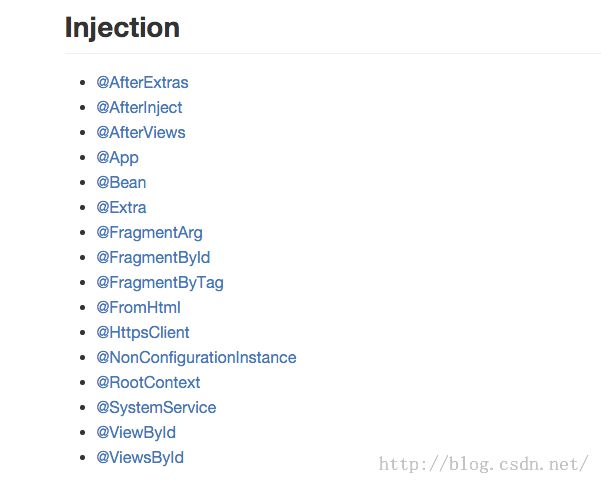【FastDev4Android框架开发】AndroidAnnnotations注入框架使用之Injection标签详解(十)
转载请标明出处:
http://blog.csdn.net/developer_jiangqq/article/details/49497955
本文出自:【江清清的博客】
(一).前言:
前面我们已经对于AndroidAnnotations框架的注入组件的方式做了讲解,今天我们开始具体学习一下Injection标签使用。
FastDev4Android框架项目地址:https://github.com/jiangqqlmj/FastDev4Android
本博客已完成Injection更新如下:
(二).@AfterExtras
自AndroidAnnotations3.1起
如果你需要在extras注入之后执行相关代码,你可以在该要执行的方法上面使用@AfterExtras注解
@EActivity
public class MyClass{
@Extra
String someExtra;
@Extra
int anotherExtra;
@AfterExtras
public void doSomethingAfterExtrasInjection(){
// someExtra and anotherExtra are set tothe value contained in the incoming intent
// if an intent does not contain one of theextra values the field remains unchanged
}
}
(三).@AfterInject
如下的例子:当然我们的被@EBean注解类的构造函数被调用,它的属性还没有被注入,如果你需要在编译的时候,依赖注入的之后执行相关的代码。你可以在需要执行的方法使用@AfterInject注入。
@EBean
public class MyClass{
@SystemService
NotificationManager notificationManager;
@Bean
MyOtherClass dependency;
public MyClass() {
// notificationManager and dependency arenull
}
@AfterInject
public void doSomethingAfterInjection() {
// notificationManager and dependency areset
}
}
(
四
).
@AfterViews
使用@AfterViews注解过后的方法会在views进行绑定之后被调用。
[注]当onCreate()方法被调用的时候,然后@ViewById注入的属性还没有被执行。因此你可以在依赖注入的Views中使用@AfterViews。
实例如下:
@EActivity(R.layout.main)
public classMyActivity extends Activity {
@ViewById
TextView myTextView;
@AfterViews
void updateTextWithDate() {
myTextView.setText("Date: " +new Date());
}
[...]
同样你可以使用
@
AfterViews
注解多个方法。但是要记住,在
onCreate()
方法不要使用任务View相关的属性。
@EActivity(R.layout.main)
public classMyActivity extends Activity {
@ViewById
TextView myTextView;
@Override
public void onCreate(BundlesavedInstanceState) {
super.onCreate(savedInstanceState);
// DON'T DO THIS !! It will throw aNullPointerException, myTextView is not set yet.
// myTextView.setText("Date:" + new Date());
}
[...]
(
五
).
@A
pp
自AndroidAnnotations 2.1开始
你可以使用@App来进行注入Application类
@EActivity
public classMyActivity extends Activity {
@App
MyApplication application;
}
该同样在任何类型注入组件中进行使用,例如
:@E
B
Bean
@EBean
public class MyBean{
@App
MyApplication application;
}
(
六
).
@
Bean
在另一个注解类或者Android组件中使用这个注解类,我们可以使用@Bean;
@EBean
public classMyOtherClass {
@Bean
MyClass myClass;
}
同时你可以实现继承依赖关系
@EActivity
public classMyActivity extends Activity {
@Bean
MyOtherClass myOtherClass;
}
【注】当你在属性声明的地方使用
@Bean
注入,你总会得到一个新的实例,除非那个类是一个单例。
值得我们注意的是,注解生成的子类是final类型的,也就是说我们不能在继承生成的类。但是我们可以扩展原始的类。扩展出来的类同样可以使用注解。如下:
@EActivity
public classMyChildActivity extends MyActivity {
}
(
七
).
@
Extra
自AndroidAnnotations1.0起
@Extra注解表示Activity中的属性应该注解成Intent中相应的Extra数据,由此用来打开Activity
使用实例如下:
@EActivity
public classMyActivity extends Activity {
@Extra("myStringExtra")
String myMessage;
@Extra("myDateExtra")
Date myDateExtraWithDefaultValue = newDate();
}
自
AndroidAnnotations2.6
起
如果@Extra注解中没有提供任何值,那么将会直接使用属性的名字。
@EActivity
public classMyActivity extends Activity {
// The name of the extra will be"myMessage"
@Extra
String myMessage;
}
你可以通过Intent构建起来传递额外的数据值
MyActivity_.intent().myMessage("hello").start();
(
八
).
@
FragmentArg
使用@FragmentArg注解Fragment中的属性相当于Fragment Argument
生成的构建器的set方法总会使用argument相同的名字。默认情况下绑定值的key的名字就是该注入的属性的名字,但是你可以给以个@FragmentArg的参数值来改变它。
实例:
@EFragment
public classMyFragment extends Fragment {
@FragmentArg("myStringArgument")
String myMessage;
@FragmentArg
String anotherStringArgument;
@FragmentArg("myDateExtra")
Date myDateArgumentWithDefaultValue = newDate();
}
使用
Fragment
构建器来进行使用。
MyFragmentmyFragment = MyFragment_.builder()
.myMessage("Hello")
.anotherStringArgument("World")
.build();
(
九
).
@
FragmentById
和
@
Fragment
ByTag
我们可以在类中使用@EActivity,@EFragment,@Eview,@EViewGroup,@EBean,使用@FragmentById或者@FragmentByTag来进行注入fragments。
【注】推荐使用哪个@FragmentById而不是@FragmentByTag,因为后者没有编译时候的验证。
请注意@FragmentById和@FragmentByTag仅仅能注入fragments而不是创建它们。所以它们只能存在于Activity中
@EActivity(R.layout.fragments)
public classMyFragmentActivity extends FragmentActivity {
@FragmentById
MyFragment myFragment;
@FragmentById(R.id.myFragment)
MyFragment myFragment2;
@FragmentByTag
MyFragment myFragmentTag;
@FragmentByTag("myFragmentTag")
MyFragment myFragmentTag2;
}
(
十
).
@
FromHtml
10.1.注入HTML
自AndroidAnnotations2.2起
如果你要TextView中注入HTML文本(可能因为格式问题或者你天生喜欢使用HTML),有下面两种方式帮到你:
- @FromHtml
- @HtmlRes
现在我们假设有以下的字符串资源
<?xmlversion="1.0" encoding="utf-8"?>
<resources>
<stringname="hello_html"><![CDATA[Hello<b>World</b>!]]></string>
</resources>
10.2.@HtmlRes
这个注解首先会表现成@StringRes(获取字符串资源),然后进行包装进行调用HTML.fromHtml():
@EActivity
public classMyActivity extends Activity {
// Injects R.string.hello_html
@HtmlRes(R.string.hello_html)
Spanned myHelloString;
// Also injects R.string.hello_html
@HtmlRes
CharSequence helloHtml;
}
10.3.@FromHtml
这个@FromHtml必须被使用在TextView,并且该TextView已经被@ViewById注解了,该注解的目的就是设置HTML文本在TextView上面
@EActivity
public classMyActivity extends Activity {
@ViewById(R.id.my_text_view)
@FromHtml(R.string.hello_html)
TextView textView;
// Injects R.string.hello_html into theR.id.hello_html view
@ViewById
@FromHtml
TextView helloHtml;
}
(
十一
).
@
HttpsClient
自AndroidAnnotations2.6起
11.1.简要介绍
通过@HttpsClient注解实例简化了HTTPS请求配置秘钥,信任库和主机验证。并且所有的参数都是可选的。
11.2.双向认证
下面实例是一个完整的表单,如果你想实现验证,方式如下:
@HttpsClient(trustStore=R.raw.cacerts,
trustStorePwd="changeit",
keyStore=R.raw.client,
keyStorePwd="secret",
allowAllHostnames=false)
HttpClienthttpsClient;
- trustStore:信任库
- trustStorePwd:密码
- keyStore:秘钥
- keyStorePwd:秘钥密码
- allowAllHostnames:允许的主机名
简单的SSL身份认证如下:
@HttpsClient(trustStore=R.raw.mycacerts,
trustStorePwd="changeit")
HttpClienthttpsClient;
11.3.
默认情况
如果你没有指定信任的文件,注解会使用Android默认的信任库在/system/etc/security/cacerts.bks
@HttpsClient HttpClienthttpsClient;11.4. 使用实例
@EActivity
public classMyActivity extends Activity {
@HttpsClient(trustStore=R.raw.cacerts,
trustStorePwd="changeit",
hostnameVerif=true)
HttpClient httpsClient;
@AfterInject
@Background
public void securedRequest() {
try {
HttpGet httpget = newHttpGet("https://www.verisign.com/");
HttpResponse response =httpsClient.execute(httpget);
doSomethingWithResponse(response);
} catch (Exception e) {
e.printStackTrace();
}
}
@UiThread
public voiddoSomethingWithResponse(HttpResponse resp) {
Toast.makeText(this, "HTTP status" + resp.getStatusLine().getStatusCode(), Toast.LENGTH_LONG).show();
}
}
(
十二
).
@
NoConfigurationInstance
自AndroidAnnotations2.5开始
12.1.简要介绍
当Configuration发生改变的时候,Activity通常会被销毁然后重新创建。这样会重新加载资源。这样就涉及一个从就对象到新Activity实例的引用问题(例如:加载图片,网络连接,Activity运行的线程…)
这就是Activity.onRetainNonConfigurationInstance()用来解决这个问题。
12.2.@NonConfigurationInstance
我们通过@NonConfigurationInstance来对Activity的属性变量进行注解,在配置信息发生改变的时候来保存实例。
@EActivity
public classMyActivity extends Activity {
@NonConfigurationInstance
Bitmap someBitmap;
@NonConfigurationInstance
@Bean
MyBackgroundTask myBackgroundTask;
}
(
十三
).
@
RootContext
可以在@EBean依赖注入的类中使用@RootContext注入Android根组件,不过需要主要的时候只能注入上下文相关类型的。
@EBean
public class MyClass{
@RootContext
Context context;
// Only injected if the root context is anactivity
@RootContext
Activity activity;
// Only injected if the root context is aservice
@RootContext
Service service;
// Only injected if the root context is aninstance of MyActivity
@RootContext
MyActivity myActivity;
}
(
十四
).
@
SystemService
自AndroidAnnotations1.0起
14.1.Android系统标准服务注入
使用标准的系统服务,我们需要记得系统服务的常量名字,然后进行强制转换获取。
notificationManager= (NotificationManager) context.getSystemService(Context.NOTIFICATION_SERVICE);14.2.@ System Service
使用@SystemSerivce注解的Activity中的属性相当于使用Android系统服务,该等同于调用Context.getSystemService()方法。
@EActivity
public classMyActivity extends Activity {
@SystemService
NotificationManager notificationManager;
}
(
十五
).
@
ViewById
使用@ViewById注解Activity中的属性等相当于布局文件中的View组件。等同于调用findViewById()方法。该View的id可以设置在注解的参数中,例如@ViewById(R.id.myTextView)。如果没有设置,将会使用字段的的名字。并且字段不能为私有的。实例如下:
@EActivity
public classMyActivity extends Activity {
// Injects R.id.myEditText
@ViewById
EditText myEditText;
@ViewById(R.id.myTextView)
TextView textView;
}
(
十六
).
@
ViewsById
自AndroidAnnotations3.1起
该注解和@ViewById相似,不过该是注入一组视图View。该私用java.util.List或者android.view.view子类型的属性。该注解的参数值为R.id.*相关集合。在通过给定的IDs注入之后的views会保存在List中。但是需要检查代码避免空数据加入注入。
到此位置关于AndroidAnnotations注解Injection标签使用方法已经全部讲解完成了。
FastDev4Android项目已经添加配置了AndroidAnnotations框架,后期的框架项目中也会主要使用这个DI框架,.欢迎大家去Github站点进行clone或者下载浏览.
https://github.com/jiangqqlmj/FastDev4Android
同时欢迎大家star和fork整个开源快速开发框架项目~如果有什么意见和反馈,欢迎留言,必定第一时间回复。也欢迎有同样兴趣的童鞋加入到该项目中来,一起维护该项目。
